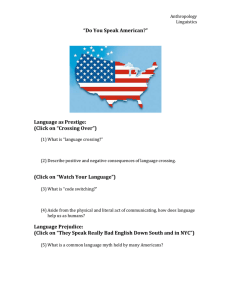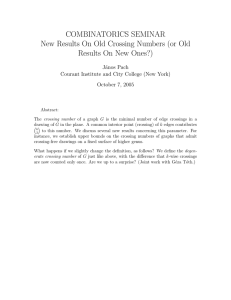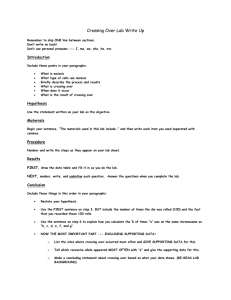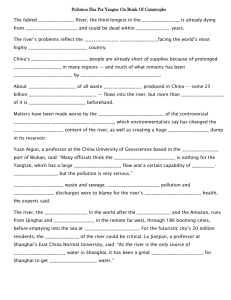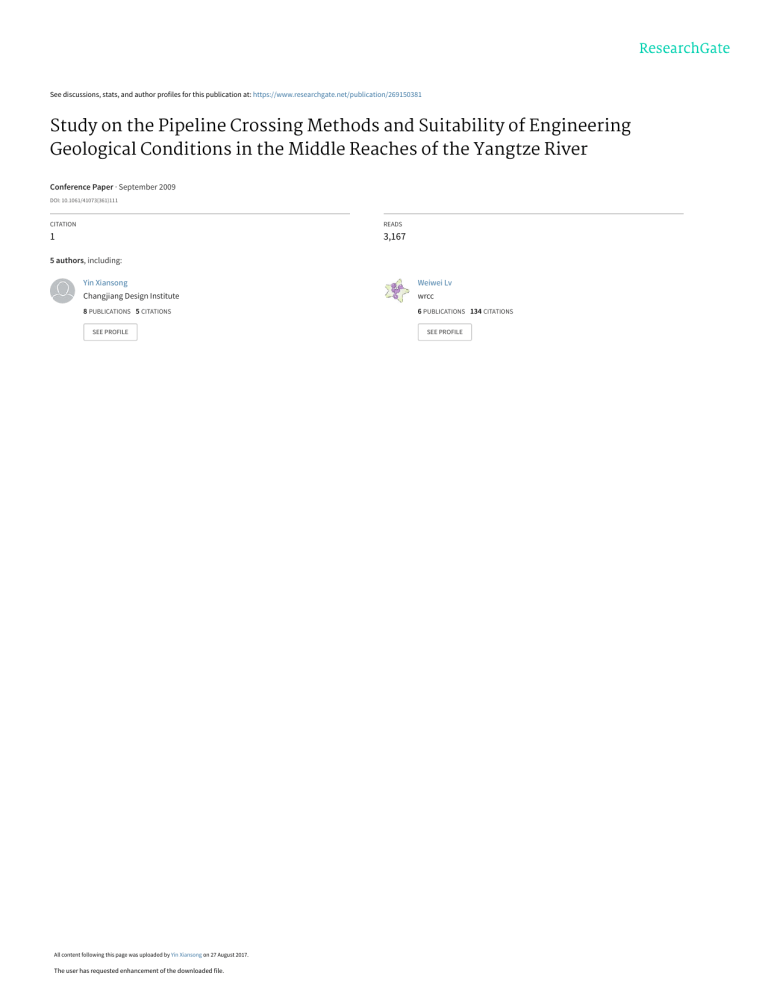
See discussions, stats, and author profiles for this publication at: https://www.researchgate.net/publication/269150381
Study on the Pipeline Crossing Methods and Suitability of Engineering
Geological Conditions in the Middle Reaches of the Yangtze River
Conference Paper · September 2009
DOI: 10.1061/41073(361)111
CITATION
READS
1
3,167
5 authors, including:
Yin Xiansong
Weiwei Lv
Changjiang Design Institute
wrcc
8 PUBLICATIONS 5 CITATIONS
6 PUBLICATIONS 134 CITATIONS
SEE PROFILE
All content following this page was uploaded by Yin Xiansong on 27 August 2017.
The user has requested enhancement of the downloaded file.
SEE PROFILE
ICPTT 2009 © 2009 ASCE
Study on the Pipeline Crossing Methods and Suitability of Engineering
Geological Conditions in the Middle Reaches of the Yangtze River
Xiansong Yin1, Weiwei Lv2, Liming Xie3, Shaoxiong Li4 and Sanding Zhang5
1
Changjiang Geotechnical Engineering Corporation, Changjiang Design Institute,
Wuhan, 430000; PH(027)82926945; email: pzw1998@hotmail.com
2
School of Environmental Studies, China University of Geosciences, Wuhan, 430074;
PH(027)61234459; email: vv_lv@hotmail.com
3
Changjiang Geotechnical Engineering Corporation, Changjiang Design Institute,
Wuhan, 430000; PH(027)82926945; email: pzw1998@hotmail.com
4
Changjiang Geotechnical Engineering Corporation, Changjiang Design Institute,
Wuhan, 430000; PH(027)82926945; email: pzw1998@hotmail.com
5
Changjiang Geotechnical Engineering Corporation, Changjiang Design Institute,
Wuhan, 430000; PH(027)82926945; email: pzw1998@hotmail.com
ABSTRACT
The methods adopted for pipeline crossing usually are: directional drilling crossing
method, mine tunneling method, shields tunneling method and so on. The
engineering geological conditions have decisive impact on the pipeline crossing
design and construction plan formulation. For the project of pipeline crossing in the
middle reach of the Yangtze River, firstly, the crossing point needs to be chosen
based on the engineering geological conditions of the crossing Yangtze section, then
the crossing method should be decided. In order to choose reasonable method, the
pipeline crossing methods and suitability of engineering geological conditions should
be fully studied.
KEYWORDS
the middle reaches of the Yangtze River; pipeline crossing; engineering geological
conditions; suitability
1047
ICPTT 2009 © 2009 ASCE
INTRIDUCTION
The Yangtze River is the longest river in China with the total length of 6300km. The
upper reaches of Yangtze river is from Jiangyuan to Yichang, the middle reaches is
from Yichang to Poyang Hukou and the lower reaches is from Hukou to yangtze
estuary. Among them, the middle reaches (from Yichang to Hukou) are about
950km, along with some large and middle sized cities such as Yichang, Jingzhou,
Wuhan, Huangshi and Yueyang.
In recent years, with the successive development of west-to-east gas pipeline project,
Zhongxian-Wuhan gas pipeline project, Yizheng-Changling crude oil pipeline
project, the projects of oil and gas crossed the middle reaches of the Yangtze river
for many times. Since the engineering geological conditions along the middle
reaches of the Yangtze river are relatively complex, the application of suitable
pipeline crossing method to the local engineering geological conditions is very
significant in the pipeline crossing project.
PIPELINE CROSSING METHODS
At present, the technologies adopted both at home and abroad for pipeline crossing
the large-sized rivers are primarily spanning and traversing. The spanning technology
is often applied for narrow, deep and nonnavigable rivers mainly with
suspended-cable and stay-cable methods. The methods for traversing technology
usually are: channel-buried method, pipe jacking method, directional drilling
crossing method, mine tunneling method, shields tunneling method and so on.
ENGINEERING GEOLOGICAL CONDITIONS OF THE MIDDLE
REACHES OF THE YANGTZE RIVER
Engineering geological conditions are the sum of all the geological factors that
impact on the engineering constructions, including topography and physiognomy,
formation lithology and their engineering geological properties, geological structure,
hydrological conditions, natural geological phenomena and processes and so on.
Topography and Physiognomy . The Yangtze River flows out of the three gorges
and then continues eastward after the Gezhouba Project, and then enter the plain area
of the middle and lower reaches. The middle reaches (Yichang-Hukou) are lacustrine
plain with well-developed water system and many lakes (Zhou, 2004). The north
bank belongs to Hanjiang water system while the south bank has Dongting and
Poyang water system. The whole middle reaches region is characterized of flat
terrain and huge area and the ground elevations of most area are lower than 50m.
Except some local narrow sections, the width of Yangtze River channel is generally
over 1km and some parts are up to 2.5km.
Formation Lithology.In the middle reaches of the Yangtze River, river bed and both
banks are basically covered by loose accumulational of Quaternary, and bedrock
mainly distributes in the hilly area of south bank of the Yangtze (see Figure 1). The
bed rock is tertiary and cretaceous (KE) red clastic rock and carbonate, magmatic
1048
ICPTT 2009 © 2009 ASCE
1049
rock and erinaceous shale in some sections. Quaternary pleistocene series (Qp)
sporadically distributes in river terrace or monadnock area along Yangtze River as
well as most of the areas in the south of Wuhan, mainly of cohesive soil with
sandstone and gravel. Quaternary holocene series(Qh) mainly distributes in modern
riverbed and overbank with sandy gravel, sand, sandy soil, cohesive soil and so on,
but some lake and river ports only have muddy soil sediments.
N
Qp
Pz
K
Pz
Yichang
Qp
Qh KE
Qp
Qp
SD
Jingzhou
E
TJ
P
Qh
Qh
Qp
Qh
Pt
Pt
Dongting Lake
> O
H
Pt
SD P SD T K E
Qp +
H
N
O
PKP-T
P-T
Qh
Jiujiang
P-T
Hukou
Qh
Yueyang
Poyang Lake
Qh
0
50
100km
Nanchang
Figure 1. The generalized geologic map (CWRC, 1999]
The loose accumulational horizon in both banks of the middle reaches of the Yangtze
River is thick with commonly dual structure feature, the subsurface is cohesive soil,
and sandy soil beneath.
Geological Structure. The middle reaches of the Yangtze River is located in the
Yangtze para-platform and mainly belongs to zone of basic seismic intensity
except some part of zone. According to the analysis of regional geological data,
aerial remote sensing and seismogeological survey, there are faults development in
surrounding area and mainly are tensional faults which belong to early faults,
besides, a few active faults distribute there. (Cheng,1994).
Hydrological Conditions. Underground water in the middle reaches of Yangtze
basin can be classified into 4 types: pore water, fissure water, fissure-pore water and
Karst water.
The aquifer of pore water is sand layer and sandy gravel in Quaternary. Phreatic
water commonly exists in the plain of the middle reaches of the Yangtze River while
one layer or several layers of confined aquifer are usually beneath phreatic aquifer
with the buried depth of 8-43m, thickness of 25-120m and medium-rich water
amount( Zhou, 2004)
The aquifer of fissure water includes clastic rock and magmatic rock, which mainly
distributes in hilly area of the east middle reaches of the Yangtze. Fissure water is
usually of phreatic water state and buries in weathered rocks of shadow parts but
partial has confined feature. The amount of fissure water is usually quite poor, but
ICPTT 2009 © 2009 ASCE
when the conditions of lithology, structure and landform are favorable for
groundwater enrichment, for example, coarse grain of sandstone, big thickness, good
continuity, fracture development, favorable landform conditions for precipitation and
surface runoff accumulation, there might be with rich groundwater.
Fissure-pore water mainly exists in tertiary cretaceous red clastic rock. Red layer
mainly consist of mudstone with sandstone, and sandstone is fissure-pore water
aquifer while mudstone is relatively aquifuge, which result in forming of interlayer
water of multi-layer structure or with confined feature.
The main aquifer of Karst water is carbonate of Carboniferous(C), Permian (P) and
Triassic (T). In the hilly area of east middle reaches of the Yangtze River, most of
Karst water is phreatic water and part of it is confined water. The karst stratum in the
strath plain area is often covered by loose sediment since Cenozoic with the buried
depth of ten to hundred meters. It is favorable to form medium-rich amount of
covered type karst water with certain confined feature.
River Geological Process. River geological processes in the middle reaches of the
Yangtze River are local erosion and accumulation, and mainly lateral erosion and
accumulation(Zhao and Lin, 2002]. The plane shape of river channel as well as its
evolution formed by river hydrodynamic-geological process is limited by geological
structure of the river valley, and which are mutual depend and interact. The
longitudinal profile of main stream riverbed in the middle and lower reaches of the
Yangtze River has not reached the equilibrium yet. It will take a long time to reach
dynamic equilibrium for the accumulative erosion in Yichang-Chenglingji section
and after Chenglingji section, especially Wuhan section (Huang, 2007).
Because of the water flow sorting effect, deposited particles obviously change from
coarse to fine upper to lower in the middle and lower reaches of the Yangtze River.
Many data indicate that, floodplain phase deposition has typical phase transformation
law. This law is: the riverbed deposition is mainly cobble and gravel and floodplain
phase deposition is cohesive soil in Yichang-Zhijiang section; while after Wuhan
section, the riverbed deposition is mainly sandstone with bottom gravels and
floodplain phase deposition is organic soil.
GENERAL REQUIREMENTS OF ENGINEERING GEOLOGICAL
CONDITIONS TO CROSSING METHOD SUITABILITY
The middle Yangtze River region is an important economic and cultural region in
China. Any one of the crossing methods should meet the requirements of engineering
geological conditions, economic benefit, route scheme, environmental protection,
construction period and so on. As pipeline go across the middle reaches of the river,
the selection of crossing method needs to meet the requirements of engineering
geological conditions.
Control Requirement of Formation Lithology. The river bed and banks of the
middle reaches of the Yangtze River are mainly deposited by Quaternary loose
sediments, and bedrock primarily consist of tertiary cretaceous red clastic rock while
carbonate, magmatic rock and sandstone rock in some sections of the river. There are
1050
ICPTT 2009 © 2009 ASCE
big differences in properties of various rocks and soils as well as strength so that the
crossing method must adapt to the features of changing formations along the route.
Suitable construction method and countermeasure need to be considered according to
the crossing formations. Sometimes, it is necessary to take auxiliary construction
facilities and also can adapt to different factors like underground crossing sections,
buried depth, route length and so on.
Control Requirement of Geological Environment. The total length of dike of the
middle and lower reaches of the Yangtze River is 3600km and the plain area along
the river which is protected by the dike is up to 12.6×104km2. However, ground
elevation is generally lower than flood level for about 5-6m, that in some places are
even over 10m, which indicates the serious flood control situation (Zhou and Zhao,
2004). The dike foundation of the middle reaches mainly consists of Quaternary
loose sediments so that the geological structure is complicated and changeable with
many geological defects. During the big Yangtze flood of whole basin in 1998, the
dangerous situations of main dike in the middle and lower reaches of the Yangtze
River takes up about 12.7% (Ma, 2001). Except some parts of hilly area, pipelines go
inevitably across the dike when crossing the middle reaches of the river, which will
result in the formation displacement and deformation more or less and also impact on
the surrounding environment. Therefore, the selection of crossing method must
firstly meet the requirement of geological environment control in order to guarantee
the safety of dike project.
Control Requirement of Hydrogeological Conditions. Groundwater is rich in
amount in part of the middle Yangtze region. Some of them have pressure bearing
capacity and the confined water head is relatively high. The selection of pipeline
crossing method must meet the demands of construction under the water-rich and
high water head conditions.
Control Requirement of River Geological Processes. The middle reaches of the
Yangtze River flowing into Yichang after the three gorges belongs to alluvial river.
The river impacts on riverbed and both banks with its huge water flow energy
continuously erode and transport substances in the riverbed and banks, and then
deposit in suitable site which changes the shape of the riverbed and banks. The
influence of scour depth on pipeline safety by rivers should be fully considered in
pipeline crossing scheme.
Control Requirement of Other Geological Factors. The selection of construction
method also needs to consider the corresponding demands of other geological
factors, like topography and physiognomy of crossing section, regional geological
environment, structural environment, unfavorable geological process and so on.
SUITABILITY ANALYSIS OF PIPELINE CROSSING
According to previous analysis, due to the big water flowing rate in the middle
reaches of the Yangtze River, the trenching-burying method can hardly make the
1051
ICPTT 2009 © 2009 ASCE
laying pipeline reach the designed depth which result in the low safety of pipeline.
Besides, navigation suspending in Yangtze River for construction is not suitable.
Therefore, this method cannot be adopted for crossing in the middle reaches of the
Yangtze. Pipe jacking method is under the influence of riverbed geological
conditions and width so that it is hardly used in crossing the river. The following is
about the suitability analysis of three pipeline crossing methods, directional drilling
crossing method, shields tunneling method and mine tunneling method, to the
engineering geological conditions in the middle reaches of the Yangtze River.
Suitability Analysis of Formation Lithologic Features. According to previous
experience, directional drilling crossing method is suitable for application in river
bed of clay layer, silt layer and medium sand stratum, but not suitable for gravel
layer (with particle diameter bigger than l00mm), drift sand layer and bedrock layer.
In recent years, with the cooperation of experts in trenchless field both at home and
abroad, the formation area suitable for directional drilling crossing is gradually
increasing. For example, the oil pipeline Dongjiang crossing engineering of Lisha oil
products warehousing and transportation project has a horizontal length of 1085m,
drilled through complicated strata with different weathering degrees of granite and
sands. In which, uniaxial saturated compressive strength of hardest rock can be
36.7MPa, operated with a large non-excavation horizontal directional drilling rig
(Chen, 2008). When trenchless directional drilling crossing method is adopted, if the
river bed mainly consists of sand and clay, and the buried depth of the pipeline is
enough, it is suitable to use directional drilling crossing method; but if there is gravel
layer or gravel-boulder bed, it is not suitable to use directional drilling crossing
method.
Shields tunneling method can be applied for rocks and soils, and the construction is
not or hardly influenced by external conditions like weather, hydrology and
navigation so that it can ensure construction progress and safety guarantee which
indicating good suitability. As for sections with complicated geological conditions,
uneven hardness formation and fault fracture zone in the middle reaches of the
Yangtze River, the selection of reasonable shield machine type, main function
setting, technical parameter, cutter head and cutting tool configuration needs to be
carried out according to specific conditions.
Mine tunneling method is suitable for crossing the bedrock or with thin overburden
layer. Mine tunneling construction is influenced by surrounding rock classification,
rock mass integrity, structural features, and conditions of filling water in the crossing
strata. The suitability of this method is good when it is characterized by high
classification of surrounding rock, intact rock mass, undeveloped fractures and so on.
However, most of the middle reaches of Yangtze region is covered by quaternary
loose sediment with thick overburden, which has big limits on the mine tunneling
construction.
To sum up, shields tunneling method is suitable for formation lithologic features in
pipeline crossing the middle reaches of the Yangtze, directional drilling method and
mine tunneling method also have relatively good suitability but with certain limits.
1052
ICPTT 2009 © 2009 ASCE
Suitability of Geological Environment Control. In directional drilling crossing
method, directional drilling machine firstly drill to designed pipeline depth by a
certain angle to form pilot hole, then extend the diameter of pilot hole to designed
size and lay the pipeline. This technology as well as its crossing formations (mainly
clay soil and sand) inevitably poses certain influence on environment. Hole is
completed by stepped reaming method with directional drilling machine. After the
completion of back towed pipe, the cyclic hydraulic force inside hole disappears and
certain negative pressure can occur inside the hole during the back towed process.
Therefore, the overlaying soil layer is prone to have creep deformation inside hole
which result in surface subsidence.
Shield is used as supporting structure in shields tunneling construction and shields
tunnel is formed by shield machine during tunneling together with overall lining
construction. The basic reason of surface deformation caused by shields tunneling
method can be attributed to formation loss and soil consolidation by construction. A
series of subsidence controlling measures like promptly backwall grouting is taken in
shields tunneling construction, which can effectively control surface subsidence. The
shields tunneling technology is well developed with good subsidence controlling
ability so that weak disturbance during construction can be realized. It has good
suitability for geological environment control.
The suitability of mine tunneling method on geological environment control is
limited by the crossing formation lithology. Mine tunneling method has little
influence on environment if it is characterized by high classification of surrounding
rock, intact rock mass, undeveloped fractures and so on. As overburden layer is
widely distributed in middle reaches of the Yangtze River, mine tunneling
construction may result in sand soil liquefaction. The impact of blasting vibration
of Yangtze embankment must be strictly controlled during mine tunneling
construction in order to guarantee the safety of flood control embankment.
Compared with other crossing methods, shields tunneling method is more
suitable for construction conditions with strict environmental requirement.
Suitability of Hydro-geological Conditions. Groundwater is abundant in part of the
middle Yangtze region. Some of them have pressure bearing capacity and the
confined water head is relatively high.
As for directional drilling crossing method, the construction is not limited by
hydro-geological conditions but groundwater has impact on the quality of directional
drill bore. When directional drill is working in sand gravel stratum, it is easy for
drilling due to the lower strength of loose sediment. As sand gravel stratum has high
permeability, property of slurry returning is not good so that the surrounding
cementing substances (soil) in formations like gravel are easily separated and
discharged with drilling mud under the washing of great pumping displacement and
high pumping pressure, which can result in hole wall collapse or even bore collapse
accident.
Crossing using shields tunneling method is conducted by tunnel construction under
the Yangtze river, and grout and water pressurized compound shield can be adopted
in construction. The prompt adjustment of tunneling parameters during the
construction can guarantee the safety of tunnel crossing Yangtze.
1053
ICPTT 2009 © 2009 ASCE
Underwater mine tunneling method has always been the difficulty in underground
engineering construction. The tunnel is located under the Yangtze River bed with
high groundwater head and abundant water source recharge. When the tunnel goes
across sections of fissure zone or fault fracture zone in surrounding rocks,
groundwater inflow and sand inflow are easy to occur. Mine tunneling method is not
very suitable for Yangtze River tunnel construction. The technology of geological
forecast or whole section pre-grouting should be used during the construction in
order to guarantee the safety of underwater tunnel construction.
Suitability of River Geological Processes. When the middle Yangtze under the
natural condition, the riverside line and mainstream line of the riverbed change a lot
and the river geological process is mainly lateral erosion and accumulation. After the
implement of bank revetment project, the change significantly decreases. Now the
bank is basically of the stable state under the protection of embankment along the
river. During the mainstream of the middle reaches of the river, the riverbed in
Yichang-Chenglingji section is mainly of erosion process while the section after
Chenglingji is mainly of deposition process.
As long as guarantee a certain crossing depth, directional drilling crossing method,
shields tunneling method and mine tunneling method are suitable for crossing the
river.
Suitability of Other Geological Factors. Other geological factors, like regional
geological environment, topographical and physiognomic conditions, geological
structure, unfavorable geological processes and so on, have impact on the selection
of crossing method.
The middle reaches of the Yangtze River is mainly located in
zone of basic
seismic intensity, which belongs to basically stable area so that it is suitable for
various crossing methods.
The width of Yangtze River riverbed is generally over 1km and the actual length of
crossing pipeline is about 2km. As the anti-twisting property of long-distance drill
pipe of directional drill is limited, the crossing length and pipe diameter are also
limited. But for shields tunneling method, the limit is relatively small.
When the pipeline crosses unfavorable geological sections, each crossing method has
its own engineering geological problems. For unfavorable geological problems, mine
tunneling method has the worst suitability.
CONCLUSIONS
Based on the various engineering geological conditions of different sections in the
middle reaches of the Yangtze River, directional drilling crossing method, mine
tunneling method, shields tunneling method can be adopted. Different crossing
method has different suitability to the engineering geological conditions of the
middle reaches of the Yangtze River and here shields tunneling method is the most
suitable.
According to the engineering geological conditions of crossing site and the suitability
of crossing method, various crossing methods can be used together in order to get a
1054
ICPTT 2009 © 2009 ASCE
better effect. For example, when the engineering geological condition of one side of
the crossing section is very complicated, but that of the other side is relatively
simple, the combination of shields tunneling method and mine tunneling method can
be applied together in the construction, which can effectively save the cost.
As pipeline cross the middle reaches of the Yangtze River, the selection of crossing
method should meet the demand of its engineering geological conditions. The
engineering geological conditions have decisive impact on the pipeline crossing so
that it is one of the most important evidences for construction organization design. A
detailed engineering geological investigation and comprehensive site evaluation need
to be conducted before construction.
During the implement of pipeline crossing project, the suitability of pipeline crossing
method should be comprehensively analyzed based on the difficulty of construction,
period, cost and maintenance and so on.
REFERENCES
Chen.Y.(2008). “Construction Practices of Long and Non-excavation Crossing
Technology in Rocks and Sands.” J.Coal Geology of China, Vol. 20, No.8,
74-76. (in Chinese)
Changjiang Water Resources Committee (CWRC). (1999). “Atlas of Yangtze River
basin.” M.SinoMaps Press, Beijing, 32-33. (in Chinese)
Cheng,Y.Q. (1994). “Concise Regional Geology of China.” M. Geological
Publishing House, Beijing, 23-25. (in Chinese)
Huang, W.D. and Wang, ZH.Y. (2007). “Fluvial process forecasting for the
middle and lower reaches of the Yangtze River.” J.Tsinghua Univ (Sci &
Tech), Vol. 47, No. 12, 2134. (in Chinese)
Liu, SH.K. (1996). “Geological environment and engineering.” M. .Sichuang
Sicence and Technology Press, Sichuang, 56-57. (in Chinese)
Ma, G.SH. (2001). “Research on major engineering geologic issues of dykes along
middle and lower stretch of the Yangtzev River.” J.Yangtze River, Vol. 32,
No. 9, 3-5. (in Chinese)
Zhao.CH.SH, Shi, L. (2002). “The river geological process and channel evolution
of the middle reaches of the Yangtze River.” J.Yangtze River, Vol. 33,
No.12, 8-10. (in Chinese)
Zhou.X.ZH. and Zhao, J.G. (2004). “Generality of geological environment and
engineering geology of Yangtze River basin.” M. China University of
Geosciences Press, Wuhan, 84-85. (in Chinese)
View publication stats
1055


